

7e Simposio de segurança Alimentar - OCT 2020 - AVALIAÇÃO DO POTENCIAL DE FORMAÇÃO DE BIOFILME POR ESPÉCIES DE LISTERIA SP. ISOLADAS DE AMOSTRAS DE ALIMENTOS. Current Opinion in Food Science Volume 37, February 2021, Microbial diversity and ecology of biofilms in food industry environments associated with Listeria monocytogenes persistence. Current Opinion in Food Science 2021, 38:xx–yy This review comes from a themed issue on Food microbiology Edited by Anderson de Souza Sant’ 2214-7993/© 2020 The Author(s).

Published by Elsevier Ltd. This is an open access article under the CC BY license ( Introduction. FOODS 04/12/19 Efficacy of Commercial Sanitizers Used in Food Processing Facilities for Inactivation of Listeria monocytogenes, E. Coli O157:H7, and Salmonella Biofilms. Bacteria entrapped in biofilms are a source of recurring problems in food processing environments.
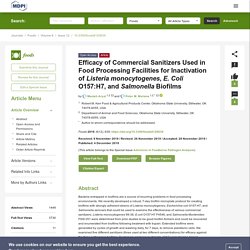
We recently developed a robust, 7-day biofilm microplate protocol for creating biofilms with strongly adherent strains of Listeria monocytogenes, Escherichia coli O157:H7, and Salmonella serovars that could be used to examine the effectiveness of various commercial sanitizers. Listeria monocytogenes 99-38, E.coli O157:H7 F4546, and Salmonella Montevideo FSIS 051 were determined from prior studies to be good biofilm formers and could be recovered and enumerated from biofilms following treatment with trypsin.
Extended biofilms were generated by cycles of growth and washing daily, for 7 days, to remove planktonic cells. We examined five different sanitizers (three used at two different concentrations) for efficacy against the three pathogenic biofilms. ►▼ Show Figures Figure 1. AKJOURNALS 12/11/20 Comparison of biofilm formation between non-pathogenic Listeria. Acta Alimentaria, Vol. 40 (Suppl.), pp. 101–108 (2011) ASSESSMENT OF BIOFILM FORMATION OF LISTERIA MONOCYTOGENES STRAINS. FRONT. MICROBIOL. 21/11/19 Biofilm Formation of Listeria monocytogenes Strains Under Food Processing Environments and Pan-Genome-Wide Association Study.
Introduction Listeria monocytogenes is a psychrotolerant Gram-positive, rod-shaped saprophytic bacterium.
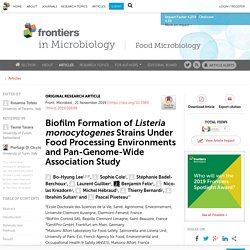
As a non-fastidious organism, it tolerates a range of stressful conditions. Its resistance to high osmolarity was demonstrated by growth up to 13% NaCl and survival under 40% NaCl (Liu et al., 2005; Shabala et al., 2008). L. monocytogenes can grow at low temperatures (Junttila et al., 2008) and its minimal growth temperature is expected to be at −2°C (Augustin et al., 2005). It withstands acidic and alkaline environments as well as low water activity conditions (Nolan et al., 1992; Koutsoumanis et al., 2003; Shen et al., 2016). Listeria monocytogenes inhabits a broad range of habitats such as soil, silage, vegetation, sewage, and river (Welshimer and Donker-Voet, 1971; Garrec et al., 2003; Vivant et al., 2013; Linke et al., 2014).
Materials and Methods. MICROORGANISMS 21/08/19 Disinfectant Susceptibility of Biofilm Formed by Listeria monocytogenes under Selected Environmental Conditions. FOODS 05/06/18 Current Knowledge on Listeria monocytogenes Biofilms in Food-Related Environments: Incidence, Resistance to Biocides, Ecology and Biocontrol. LOUGHBOROUGH UNIVERSITY - 2005 - Thèse en ligne : Listeria innocua: growth and biofilm formation. Int J Food Microbiol. 2018 Mar 28; Listeria monocytogenes strains show large variations in competitive growth in mixed culture biofilms and suspensions with bacteria from food processing environments. JavaScript is disabled on your browser.
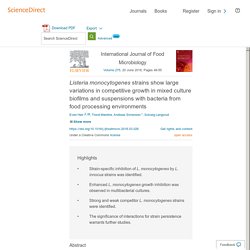
Please enable JavaScript to use all the features on this page. Highlights Strain-specific inhibition of L. monocytogenes by L. innocua strains was identified. ITALIAN JOURNAL OF FOOD SAFETY - 2017 - Listeria monocytogenes biofilm production on food packaging materials submitted to physical treatment. Abstract Listeria monocytogenes (L.m.) is an agent of serious foodborne illness.

It is a major concern for the food industry, since microorganism, growing in biofilms is protected against cleaning and disinfection and is difficult to eradicate. Aim of this study was to develop a protocol to assess the ability of two flexible packaging materials, named HGP40 and GND35, submitted to corona discharge treatment, to limit the production of L.m. biofilm at 12±1°C. JOURNAL OF BASIC MICROBIOLOGY 08/06/17 Inhibition strategies of Listeria monocytogenes biofilms—current knowledge and future outlooks. Abstract There is an increasing trend in the food industry on the Listeria monocytogenes biofilm formation and inhibition.
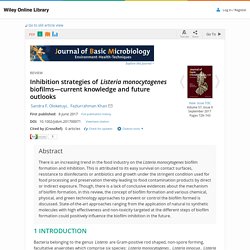
This is attributed to its easy survival on contact surfaces, resistance to disinfectants or antibiotics and growth under the stringent condition used for food processing and preservation thereby leading to food contamination products by direct or indirect exposure. Brazilian Journal of Microbiology Available online 9 February 2017 Growth, viability and architecture of biofilms of Listeria monocytogenes formed on abiotic surfaces. Abstract The pathogenic bacterium Listeria monocytogenes can persist in food processing plants for many years, even when appropriate hygienic measures are in place, with potential for contaminating ready-to-eat products and, its ability to form biofilms on abiotic surfaces certainly contributes for the environmental persistence.

In this research, L. monocytogenes was grown in biofilms up 8 days attached to stainless steel and glass surfaces, contributing for advancing the knowledge on architecture of mature biofilms, since many literature studies carried out on this topic considered only early stages of cell adhesion. In this study, biofilm populations of two strains of L. monocytogenes (serotypes 1/2a and 4b) on stainless steel coupons and glass were examined using regular fluorescence microscopy, confocal laser scanning microscopy and classic culture method. International Journal of Food Microbiology Volume 237, 21 November 2016, Variability of Listeria monocytogenes strains in biofilm formation on stainless steel and polystyrene materials and resistance to peracetic acid and quaternary ammonium compounds. Italian Journal of Food Science 24 (3):203-213 · January 2012 LISTERIA MONOCYTOGENES: BIOFILM IN FOOD PROCESSING.
Int J Food Microbiol. 2016 Apr 16;223:63-74. Genes involved in Listeria monocytogenes biofilm formation at a simulated food processing plant temperature of 15 °C. Highlights 11,024 L. monocytogenes Tn mutants were mined for genes impacting biofilm formation.

At 15 °C, disruptions in genes dltB, lmo1080, lgt, lmo1068 reduced biofilm formation. Himar1 Tn insertions in flaA, cheR, lmo0543, lmo1224 increased biofilm formation. Several biofilm mutants were resistant to DNase, proteinase K or pectinase treatments. Susceptibility to benzalkonium chloride decreased with biofilm maturity and amount. Abstract Listeria monocytogenes is a pathogenic foodborne bacterium whose persistence in food processing environments is in part attributed to its biofilm formation.
Keywords. AEM - MARS 2015 - Exploring the Diversity of Listeria monocytogenes Biofilm Architecture by High-Throughput Confocal Laser Scanning Microscopy and the Predominance of the Honeycomb-Like Morphotype. UNIVERSIDADE DE SAO PAULO - 2015 - Thèse en ligne : Staphylococcus aureus and Listeria monocytogenes isolate from dairy plants: occurrence, evaluation of biofilm formation ability and inactivation by peracetic acid and cold plasma. Jundishapur J Microbiol. 2015 May; 8(5): e17430. Evaluating the Effect of Copper Nanoparticles in Inhibiting Pseudomonas aeruginosa and Listeria monocytogenes Biofilm Formation.
AEM - 2014 - Exploring the diversity of Listeria monocytogenes biofilm architecture by high-throughput confocal laser scanning microscopy: predominance of honey-comb-like-morphotype. PLOS 11/09/15 Biofilm-Forming Abilities of Listeria monocytogenes Serotypes Isolated from Different Sources. Abstract A total of 98 previously characterized and serotyped L. monocytogenes strains, comprising 32 of 1/2a; 20 of 1/2b and 46 of 4b serotype, from clinical and food sources were studied for their capability to form a biofilm.
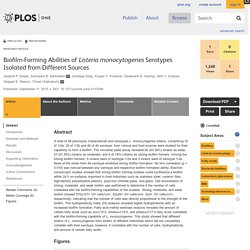
The microtiter plate assay revealed 62 (63.26%) strains as weak, 27 (27.55%) strains as moderate, and 9 (9.18%) strains as strong biofilm formers. Among the strong biofilm formers, 6 strains were of serotype 1/2a and 3 strains were of serotype 1/2b. None of the strain from 4b serotype exhibited strong biofilm formation. No firm correlation (p = 0.015) was noticed between any serotype and respective biofilm formation ability. Citation: Doijad SP, Barbuddhe SB, Garg S, Poharkar KV, Kalorey DR, Kurkure NV, et al. (2015) Biofilm-Forming Abilities of Listeria monocytogenes Serotypes Isolated from Different Sources. Journal of Biotech Research - 2012 - Genome-wide screening of genes required for Listeria monocytogenes biofilm formation. International journal of food microbiology 182-183C: 2014 May 11 pg 26-36 Numerical spatio-temporal characterization of Listeria monocytogenes biofilm.
Acta Univ. Sapientiae, Alimentaria, (2012) 5–17 Formation and removal of Listeria monocytogenes and Lactococcus lactis biofilms. FORMATEX - 2013 - Listeria monocytogenes, biofilm formation and fresh cut produce. YOULAB 29/08/12 Caractérisation de Listeria monocytogenes et de sa capacité à former des biofilms. Auteur: François Xavier Bergeron, 2011.
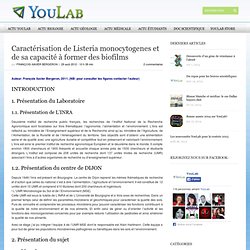
(NB: pour consulter les figures contacter l’auteur) 1. Présentation du Laboratoire 1.1. Présentation de L’INRA Deuxième institut de recherche public français, les recherches de l’Institut National de la Recherche Agronomique sont focalisées sur trois thématiques: l’agronomie, l’alimentation et l’environnement. 1.2. Depuis 1946 l’Inra est présent en Bourgogne. Avec ce stage j’ai pu intégrer l’équipe 4 de l’UMR MSE dont le responsable est Alain Hartmann.
BLOG D ALBERT AMGAR 05/06/13 Evaluation de la diversité de la formation de biofilms de Listeria monocytogenes : Impact des condi.
BLOG D ALBERT AMGAR 05/06/13 Evaluation de la diversité de la formation de biofilms de Listeria monocytogenes : Impact des conditions de croissance, du sérotype et de l’origine de la souche – guatemalt
International Food Research Journal - 2013 - Assessing biofilm formation by Listeria monocytogenes. International Food Research Journal 20(3): 1485-1490 (2013) Efficiency of four Malaysian commercial disinfectants on removing Li.
Références universitaires. African Journal of Biotechnology Vol. 11(61), pp. 12475-12482, 31 July, 2012 Adhesive ability and biofilm metabolic activity of. Full Length Research Paper Rihab BEN SLAMA#*, Karima BEKIR#, Hanen MILADI, Amira NOUMI and Amina BAKHROUF Laboratoire d’Analyses, Traitement et Valorisation des Polluants de l’Environnement et des Produits, Faculté de Pharmacie, Université de Monastir, rue Avicenne 5000 Monastir, Tunisie. Email: rbs_23@yahoo.fr. Biofilms: Impact on the Food Industry. SANITATION | June/July 2012 By Michael Cramer Last month, I went to the dentist for my routine 6-month checkup. Maintaining good oral health has always been important to me and was stressed in our family when I was growing up.
As my father used to quip, “Be true to your teeth or your teeth will be false to you.” The dental hygienist cleaning my teeth asked if I brush my teeth manually or if I use an electric toothbrush. Letters in Applied Microbiology 2004, 38, 428–432 Biofilm formation by Salmonella spp. and Listeria monocytogenes on plastic sur. Appl Environ Microbiol. 2012 Mar;78(5):1454-65. Epub 2011 Dec 22. Small-molecule modulators of Listeria monocytogenes biofilm de. Biofilms Volume1 / Issue02 / April 2004, pp 107-121 Listeria monocytogenes: biofilm formation and persistence in food-processing. E-Journal of Chemistry Volume 7 (2010), Impact of Hydrogen Peroxide on Growth and Survival of Listeria Monocytogenes Biofilms. FOOD PRODUCTION 29/09/09 Listeria biofilm under attack from new disinfectant . Sterilix Corporation and an ARS researcher claim to have developed a 100 per cent effective disinfectant for removing biofilms containing Listeria monocytognes from meat processing facilities.
L. monocytognes can thrive on the work surfaces of meat processing plants because it can withstand low temperatures and can even grow in or on refrigerated foods. The hardy pathogen is also a serious public health problem. According to the US Department of Agriculture (USDA), L. monocytognes causes serious illness in 2,500 people a year, resulting in 500 deaths. Collaboration To help companies fight the problem, Sterilex Corporation joined forces with Agriculture Research Service (ARS) microbiologist Judy Arnold. Biofilms are layers of protein and polysaccharides that surround bacteria and stick to equipment surfaces. Journal of Food Protection®, Volume 59, Number 8, August 1996 Growth of Listeria monocytogenes as a Biofilm on Various Food-Proc. Appl. Environ. Microbiol. December 2006 vol. 72 no. 12 Resistance of Listeria monocytogenes Biofilms to Sanitizing Agents in a S. Renc. Rech. Ruminants, 2003, 10 Virulence de Listeria monocytogenes en biofilm : conséquences en élevage laitier.
Journal of Food Science - 2011 - Biofilms of Listeria monocytogenes Produced at 12◦C either in Pure Culture or in Co-Culture wit. International Journal of Biotechnology & Biochemistry - 2010 - Evaluation of Antibiotic Susceptibility in Mixed Culture Biofilms. International Journal of Food Microbiology - Mixed species biofilms of Listeria monocytogenes and Lactobacillus plantarum show enhanced resistance to benzalkonium chloride and peracetic acid. E-Journal of Chemistry Volume 7 (2010), Impact of Hydrogen Peroxide on Growth and Survival of Listeria Monocytogenes Biofilms. Food Control, 2012, Vol. 25 (1), p. 1-9 Elimination des biofilms de Listeria monocytogenes, Staphylococcus aureus et Escherichia. L'adresse du site bibliomer change. Rendez-vous sur. Czech J. Food Sci. Vol. 28, 2010, No. 4: 326–332 Resistance of Listeria monocytogenes Biofilms to Disinfectants. Brazilian Journal of Microbiology - Quantification of biofilm production on polystyrene by Listeria, Escherichia coli and Staphylococcus aureus isolated from a poultry slaughterhouse.
Quantification of biofilm production on polystyrene by Listeria, Escherichia coli and Staphylococcus aureus isolated from a poultry slaughterhouse Laura Beatriz RodriguesI, II, *; Luciana Ruschel dos SantosI; Vinícius Zancanaro TagliariI; Natalie Nadin RizzoI; Graciela TrenhagoI; Amauri Picollo de OliveiraI; Franciane GoetzI; Vladimir Pinheiro do NascimentoII IFaculdade de Agronomia e Medicina Veterinária, Universidade de Passo Fundo, Passo Fundo, RS. Brasil IIFaculdade de Veterinária, Universidade Federal do Rio Grande do Sul, Porto Alegre, RS. Brasil This study assessed biofilm formation on polystyrene by Staphylococcus aureus, Listeria monocytogenes, L. welshimeri and Escherichia coli, isolated from a slaughtering plant, grown on tryptic soy broth (TSB) using different glucose concentrations.
Key words: Listeria, Escherichia coli, Staphylococcus aureus, biofilm, polystyrene. Brazilian Journal of Microbiology (2010) 41: 97-106 BIOFILM FORMATION BY Listeria monocytogenes ON STAINLESS STEEL SURFACE AND B. Ciênc. Tecnol. Aliment. vol.30 no.4 Campinas Oct./Dec. 2010 Elongated cells of Listeria monocytogenes in biofilms in the presenc. Elongated cells of Listeria monocytogenes in biofilms in the presence of sucrose and bacteriocin-producing Leuconostoc mesenteroides A11 Formação de células alongadas de L. monocytogenes em biofilmes na presença de sacarose e Leuconostoc mesenteroides A11 produtor de bacteriocina Regiane Priscilla Ratti; Bruna Carrer Gomes*; Rafael Chacon Ruiz Martinez; Vanessa Maciel Souza; Elaine Cristina Pereira De Martinis Departamento de Análises Clínicas, Toxicológicas e Bromatológicas, Faculdade de Ciências Farmacêuticas de Ribeirão Preto, Universidade de São Paulo - USP, Ribeirão Preto - SP, Brasil, E-mail: bruna.carrer@gmail.com Listeria monocytogenes is a foodborne pathogen which may survive in biofilms and persist in food processing plants.
Keywords: L. monocytogenes; biofilm; elongated cells; lactic acid bacteria; bacteriocins. Palavras-chave: L. monocytogenes; biofilme; células alongadas; bactérias láticas; bacteriocinas. 1 Introduction. American Journal of Microbiology 3 (1): 7-17, 2012 Antibiotic Resistance in Co-Culture Biofilm of Listeria monocytogenes J0161. Advances in Genomics and Genetics 2012:2 1–18 Time-dependent gene expression pattern of Listeria monocytogenes J0161 in biofilms. Inox et biofilm et Listeria.